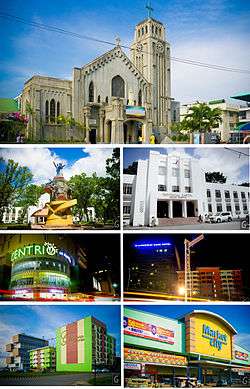Cagayan de Oro
| Cagayan de Oro City | |
|---|---|
| Highly Urbanized City | |
| City of Cagayan de Oro | |
|
From top, left to right: St. Augustine Cathedral, Misamis Oriental Cultural Heritage Monument, Misamis Oriental Provincial Capitol, Centrio Ayala Mall, Limketkai Center, Pueblo de Oro Business IT Park, Market City | |
|
Nickname(s):
| |
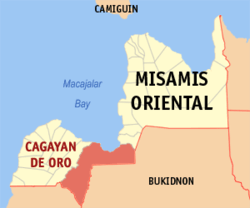 Map of Misamis Oriental with Cagayan de Oro highlighted | |
.svg.png) Cagayan de Oro Location within the Philippines | |
| Coordinates: 8°29′N 124°39′E / 8.48°N 124.65°ECoordinates: 8°29′N 124°39′E / 8.48°N 124.65°E | |
| Country | Philippines |
| Region | Northern Mindanao (Region X) |
| Province | Misamis Oriental (geographically only) |
| Districts | 1st & 2nd districts of Cagayan de Oro |
| Settled | 1871 |
| Cityhood | June 15, 1950 |
| Highly Urbanized City | November 22, 1983 |
| Barangays | 80 |
| Government[1] | |
| • Type | Mayor–council |
| • Mayor | Oscar Moreno (Liberal Party) |
| • Vice Mayor | Rainier Joaquin Uy (Liberal Party) |
| Area[2] | |
| • City | 412.8 km2 (159.4 sq mi) |
| Elevation | 10.0 m (32.8 ft) |
| Population (2015 census)[3] | |
| • City | 675,950 |
| • Density | 1,600/km2 (4,200/sq mi) |
| • Metro | 1,121,564[4][5] |
| • Languages | Mindanao Cebuano, Filipino, English |
| Demonym(s) | Cagayanons; Kagay-anons |
| Time zone | PST (UTC+8) |
| ZIP code | 9000 |
| Dialing code | +63 (0)88 |
| Abbreviations | CdeO, CDO, CDOC, Cag. de Oro |
| Website |
cagayandeoro |
Cagayan de Oro (Cebuano: Dakbayan sa Cagayan de Oro; Filipino: Lungsod ng Cagayan de Oro) is a first class highly urbanized city and the capital of the province of Misamis Oriental. It is a chartered city where governance is independent and separate from Misamis Oriental. It also serves as the regional center and business hub of Northern Mindanao (Region X), and part of the growing Metropolitan Cagayan de Oro area, which includes the city of El Salvador, towns of Opol, Alubijid, Laguindingan, Gitagum at the western side, and towns of Tagoloan, Villanueva, Jasaan, Claveria at the eastern side.
The City of Cagayan de Oro is located along the north central coast of Mindanao island facing Macajalar Bay and is bordered by the municipalities of Opol to the west; Tagoloan to the east, and the provinces of Bukidnon and Lanao del Norte to the south of the city. According to the 2015 census, the city has a population of 675,950, making it the 10th most populous city in the Philippines.[3]
Cagayan de Oro is also famous for its whitewater rafting or kayaking adventures, one of the tourism activities being promoted along the Cagayan de Oro River.[6][7][8]
Etymology
The name Cagayan de Oro (lit. River of Gold)[9] can be traced back to the arrival of the Spanish Augustinian Recollect friars in 1622, the area around Himologan (now Huluga), was already known as "Cagayán". Early Spanish written documents in the 16th century already referred to the place as "Cagayán".
The region of Northern Mindanao, which included Cagayan de Oro, was granted as Encomienda to a certain Don Juan Griego on January 25, 1571. It was then former Vice President of the Philippines Emmanuel Peláez who appended de Oro to Cagayan.
There are also other places in the Philippines with the Cagayan name; these include the province of Cagayan in northern Luzon and the Cagayan islands in the Sulu Sea.
History
The area was first inhabited around 377 C.E. (the late Neolithic period), island natives lived in a settlement then known as Himologan[10] (now known as Huluga), eight kilometers from present-day Cagayan de Oro. The natives were polytheistic animists. Austronesian in origin with seafaring capabilities like the Badjaos. Their customs were closely related to the prosperous Rajahnate of Butuan with rich Sri Vijayan (Visayan) and Indian culture. Tribal and traditional costumes and dressings have similarities with Bali, Indonesia. Ceramics were found in the area, Chinese had probably visited from Song to Ming dynasty period. Possibly an old thriving port of Srivijaya Empire with overseas trading link to China, India and even America.
Spanish colonial period
In 1622, two Spanish Augustinian Recollect missionaries came in contact with the natives of Himologan and in 1626, Fray Agustín de San Pedro persuaded the chief of Himologan, Datu Salangsang, to transfer his settlement down the Cagayan River, to the present-day Gaston Park. De San Pedro later fortified the new settlement against Sultan Kudarat's raiders.
In 1738, Spanish dominance was felt in Cagayan de Oro. When Misamis gained the status of province in 1818, one of its four districts was the Partidos de Cagayan. In 1871, the "Partidos" became a town and was made a permanent capital of Misamis.
On February 27, 1872, Governor-General Carlos María de La Torre issued a decree declaring Cagayan the permanent capital of Segundo Distrito de Misamis. During this era, the name of the town was known as Cagayan de Misamis.
In 1883, the town became a seat of the Spanish government in Mindanao for the provinces of Misamis Oriental, Misamis Occidental, Bukidnon and Lanao del Norte.
On January 10, 1899, Cagayan de Misamis joined the government of Emilio Aguinaldo and celebrated its independence from Spain. It was the second time the Aguinaldo government was declared and the new Philippine flag raised on the Mindanao island. By virtue of the 1898 Treaty of Paris, Spain ceded the Philippines to the United States; this caused friction and resulted in the Philippine-American War.
American colonial period
On March 31, 1900, Americans occupied the town of Cagayan de Misamis and on April 7, 1900, a battle erupted in the town center led by General Nicolas Capistrano[11] and Filipino resistance fighters. This would later become known as the Battle of Cagayan de Misamis. The Americans won the war, and about forty years later, gave the Philippines its independence on July 4, 1946.[12] The war years in Cagayan de Oro were prompted by the presence of the Americans in 1898. The Americans were initially and successfully repulsed by the Kagay-anons forces led by Mayor Don Apolinar Vélez at the historic Battle of Makahambus on June 4, 1900.
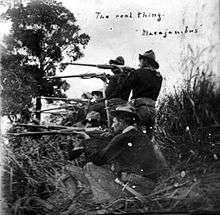
After the troubled years, peace finally brought back the economic activities to normalcy under the guidance of the United States. Consequently, from a purely farming-fishing area, Cagayan de Oro emerged into a booming commerce and trade center.
In 1948, the barrios of El Salvador and Molugan with their sitios known as Sala, Sambulawan, Sinaloc, Lagtang, Talaba, Kalabaylabay and Hinigdaan were separated from Cagayan de Oro to form the town of El Salvador.[13]
In 1950, the barrios of Opol, Igpit, and lower Iponan were separated from Cagayan de Oro to form the town of Opol.[14]
Cityhood
On June 15, 1950, President Elpidio Quirino signed Republic Act No. 521, which granted the status of a chartered city to the Municipality of Cagayan de Misamis.[15] This was made possible through the efforts of then Cagayan de Oro Congressman Emmanuel Pelaez.[16]
Cagayan de Oro was then declared a highly urbanized city by the Ministry of Local Government on November 22, 1983.
Tropical Storm Washi
On the evening of December 16–17, 2011, Tropical Storm Washi (locally called Sendong) caused widespread flash flooding in Northern Mindanao. In Cagayan de Oro, hundreds living near the banks of the Cagayan de Oro River were killed, with hundreds still missing.
Officials said that despite government warning, some people did not evacuate. Five people were killed in a landslide, but others died in the flash floods. The flash flooding occurred overnight, following 10 hours of rain, compounded by overflowing rivers and tributaries. Most of the victims had been sleeping.
In some areas, up to 20 centimeters of rain fell in 24 hours. More than 2,000 were rescued, according to the Armed Forces of the Philippines (AFP), and at least 20,000 people were staying in 10 evacuation centers in Cagayan de Oro. Officials were also investigating reports that an entire village was swept away.[17] The confirmed death toll from the disaster is 1,268.[18]
Geography
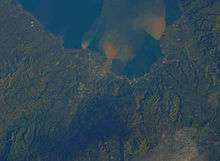
Cagayan de Oro is located along the north central coast of Mindanao, the second-largest island in the Philippine archipelago.
The southern part of the city is bordered by the provinces of Bukidnon and Lanao del Norte. The municipality of Opol borders the city on the west and Tagoloan, Misamis Oriental to the east. To the north lies Macajalar Bay facing the Bohol Sea.
Its total land area is 488.86 km² representing 13.9 percent of the entire Misamis Oriental province. It includes 25 kilometers of coastline and a harbor, Macajalar Bay. 44.7 percent of Cagayan de Oro is classified as agricultural land, while 38.4 percent is classified as open spaces.[19]
The city is frequently categorized and referenced according to geographic factors: the 1st District (west of the Cagayan River) consisting of 24 barangays which are mostly suburban, and the 2nd District (east of the river), made up of 17 barangays, including city proper barangays numbering from 1-40.
Climate
Under the Köppen climate classification system, Cagayan de Oro has a tropical climate with an annual average temperature of 28 °C. In June 1998, the city recorded its highest temperature to date of 39 °C.
Cagayan de Oro does not receive an even amount of rainfall throughout the year. The driest months are March and April while August and September are the wettest months. The rainy or wet season lasts from June until November with the relatively drier seasons lasting from December until May. The city lies outside the typhoon belt but is affected by the Inter-Tropical Convergence Zone.
| Climate data for Cagayan de Oro, Philippines | |||||||||||||
|---|---|---|---|---|---|---|---|---|---|---|---|---|---|
| Month | Jan | Feb | Mar | Apr | May | Jun | Jul | Aug | Sep | Oct | Nov | Dec | Year |
| Record high °C (°F) | 37 (99) |
38 (100) |
38 (100) |
38 (100) |
38 (100) |
39 (102) |
37 (99) |
37 (99) |
36 (97) |
37 (99) |
38 (100) |
37 (99) |
39 (102) |
| Average high °C (°F) | 30 (86) |
30 (86) |
31 (88) |
32 (90) |
32 (90) |
32 (90) |
31 (88) |
32 (90) |
31 (88) |
31 (88) |
31 (88) |
30 (86) |
31 (88) |
| Daily mean °C (°F) | 27 (81) |
27 (81) |
27 (81) |
28 (82) |
29 (84) |
28 (82) |
28 (82) |
28 (82) |
28 (82) |
28 (82) |
27 (81) |
27 (81) |
28 (82) |
| Average low °C (°F) | 23 (73) |
23 (73) |
23 (73) |
25 (77) |
25 (77) |
25 (77) |
24 (75) |
24 (75) |
24 (75) |
24 (75) |
24 (75) |
23 (73) |
24 (75) |
| Record low °C (°F) | 17 (63) |
17 (63) |
18 (64) |
20 (68) |
22 (72) |
18 (64) |
17 (63) |
21 (70) |
22 (72) |
18 (64) |
20 (68) |
18 (64) |
17 (63) |
| Average rainy days | 10 | 7 | 6 | 6 | 8 | 13 | 14 | 14 | 15 | 15 | 11 | 11 | 130 |
| Source: Weatherbase[20] | |||||||||||||
Demographics
| Population census | |||||||||||||||||||||||||||||||||||||||||||
|---|---|---|---|---|---|---|---|---|---|---|---|---|---|---|---|---|---|---|---|---|---|---|---|---|---|---|---|---|---|---|---|---|---|---|---|---|---|---|---|---|---|---|---|
|
| ||||||||||||||||||||||||||||||||||||||||||
| Source: National Statistics Office[3][21] | |||||||||||||||||||||||||||||||||||||||||||
As of the 2015 census, the city has a population of 675,950, making it the 10th most populous city in the Philippines and 3rd most populous in Mindanao after Zamboanga City.[3]
About 44 percent of the household population in Cagayan de Oro classified themselves as ethnically mixed people, 22.15 percent as Cebuano, 4.38 percent as Boholano, while 28.07 percent as other ethnic groups. (2000 Census).[22]
Religion
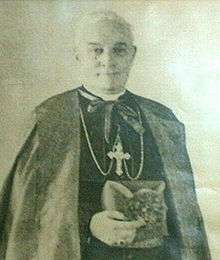
Roman Catholicism is the city's dominant religion, represented by almost 80 percent of the population. Other religious affiliations include the Seventh-day Adventist Church, Iglesia ni Cristo, Philippine Independent Church, United Church of Christ in the Philippines, Christ's Commission Fellowship, Baptists, United Methodist Church, Jesus Miracle Crusade, and Islam.
The Archdiocese of Cagayan de Oro comprises the three civil provinces of Misamis Oriental, Bukidnon, Camiguin and the entire Caraga region. It is a metropolitan seat on the island of Mindanao.
The current archbishop in Cagayan de Oro is Most Reverend Antonio J. Ledesma, S.J., D.D. , who was installed on March 4, 2006, and his seat is located at St. Augustine Metropolitan Cathedral.
Recently, the Basilica of the Black Nazarene in Quiapo Church decided to move the replica statue of the Black Nazarene to Jesus Nazareno Parish Church in Cagayan de Oro along Claro M. Recto Avenue, so that the Black Nazarene devotees from Mindanao do not have to travel to Quiapo in Manila for their annual pilgrimage.
Protestant missionary activity in the city started in 1916, although have grown in numbers in the recent decades. One of the known Protestant groups in the city is Pentecostalism, which dramatically increased with 2.8 percent in total population About 20 churches have settled in the metropolitan area. Celebration International Church has one of the highest member attendances with a record of 735 members. In addition, three main Pentecostal mother churches are situated in the suburban area and few in the metropolitan areas. Also, Adventists, Mormons, and Methodists have also grown in numbers within the suburban areas.
Islam is practiced mainly by Maranao settlers and the Balik Islam members. There are several large mosques and about 50 small mosques that can be found in the city. Masjid Sharif Alawi in Barangay Balulang is the largest mosque in Northern Mindanao, with over 3,200 square meters in land area, which also includes a madrasa and seminar building.
Buddhism and Taoism are practiced by majority of local Chinese.
Languages
Mindanao Cebuano is primarily the spoken language in the city. Tagalog (Filipino) serves as the city's secondary language. English is mainly used for business and in the academe. Maranao is widely spoken within Maranao communities in the city.
Economy
Cagayan de Oro is the melting pot of Mindanao because of its accessibility, business growth, attractions and its warm and hospitable people. Being the regional center, logistics and business hub of Northern Mindanao, the city is one of the most progressive and competitive cities in the Philippines.[23]
Cagayan de Oro as the economic center of Northern Mindanao (Region 10) fuels the region’s growth due to its economic dynamism, government efficiency, access to an enormous concentration of City's markets of more than 600,000 people, appropriate infrastructure such as the multi-berth Macabalan Baseport, the Mindanao Container Terminal (MCT) which facilitates direct and cost-efficient movement of containerized cargoes to Manila, Cebu and international shipping hubs, Laguindingan Airport which services air logistics requirements, and energy power supply which is approaching self-reliance with Minergy’s 27.4-MW and 18.9-MW diesel power plants, STEAG State Power’s 210-MW coal-fired power plant, 1.6-MW Agusan Hydroelectric Plant, 8-MW Cabulig Hydropower, Bubunawan Power Company’s 7-MW run-off river hydro power in tandem with Cepalco’s 1-MW photovoltaic solar power plant —the only grid-connected PV power plant in the Philippines, 12.5-MW Kirahon photovoltaic solar plant, and 165-MW coal power of Minergy Coal Corporation to be operational by March 2017 and this will be added 110-MW by 2019 to meet the growing power demand of Cagayan de Oro.
Cagayan de Oro due to its strategic location prompted Pilipinas Shell Petroleum Corporation to put up its multi-billion peso fuel import facility, dubbed as the North Mindanao Import Facility (NMIF) to cater to the power and energy needs of millions of residents, motorists and other end-users and consumers in Visayas and Mindanao.
The city's economy is largely based on industry, commerce, trade, service and tourism. Investment in Cagayan de Oro City for the first six months of 2012 reached 7.4 billion pesos outpacing the local government's expectation of to nearly 100 percent. Investments in the city are dominated by malls, hotels, condominiums, subdivisions, industrial and power plants. The net income for 2012 pegged at 2,041,036,807.89 billion pesos.
Business districts
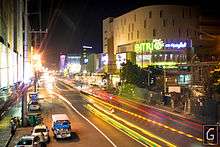
Business districts in Cagayan de Oro City are clustered areas of major economic and public services where the public go to for their various needs. These are: the Divisoria Business Area where the Divisoria plaza, Xavier University, Lourdes College, Govt. and private offices, several stand alone stores are located; the Lapasan-CMRecto Business Area where Limketkai, Ayala, Gaisano City Mall, and SM Premier, Several Hotels, Northern Mindanao Regional Hospital, Mindanao University of Science and Technology are located; the Lower Carmen Business Area where Carmen Market and several stand alone stores and banks, and Phinma Cagayan de Oro College, Madona & Child Hospital, and PLDT-Philcom are located; the Uptown Business Area where SM City, banks and several stand alone stores along Masterson Ave. are located; the Cogon Business Area where Cogon Market, Maria Reyna and Xavier Hospital, several hotels, stand-alone Gaisano department stores (Gaisano Cogon, Gaisano Osmeña and Gaisano SukiClub), Ororama Supercenter, auto hardware stores along Osmeňa St. are located; the Kauswagan Highway & Pelaez Blvd. Business Area where Georgetown Cybermall, Liceo University, Savemore, Kong Hua School, banks (PNB, BPI, Security, BDO), Polymedic Medical Plaza, car dealers of various brands (Toyota, Ford, Chevrolet, Subaru, Mitsubishi, Nissan, Hyundai, Mazda), S&R Membership Store, N-Hotel, and a good number of Motels are located; the Bulua Business Area where Westbound Terminal, City Mall, BIR Office, LTO, Gaisano Bulua Mall, Home Depo and several stand alone stores are located; the Agora Business Area where the Eastbound terminal and Market City are located; the Puerto Business Area where Gaisano Puerto Mall, Puerto Public Market, Puerto Community Hospital are located.
Big industries
Cagayan de Oro City is the home of two multinational companies, Del Monte and Nestlé, and local manufacturing companies, Cagayan Corn Products and Alwana Wood Products. UKC Builders, Gampik Construction & Development, and Jejors Construction Corporation are construction firms classified as triple which are all located in the city.
Bank industry
Cagayan de Oro City as the regional economic center of Northern Mindanao houses the Regional Office of the Bangko Sentral ng Pilipinas (Central Bank of the Philippines). As of June 2016, at least 70 banks are operating in the city.
The universal and commercial banks are Bank of the Philippine Islands (BPI) with 8 branches, BDO Unibank (Banco de Oro) with 9 branches, United Coconut Planters Bank (UCPB) with 6 branches, Philippine National Bank (PNB) with 4 branches, Metropolitan Bank and Trust Company (Metrobank) with 5 branches, BPI Family Bank with 3 branches, Union Bank of the Philippines (UnionBank) with 3 branches, Rizal Commercial Banking Corporation (RCBC) with 3 branches, Land Bank of the Philippines (Landbank) with 3 branches, Chinabank with 3 branches, Development Bank of the Philippines (DBP) with 2 branches, Security Bank with 3 branches, EastWest Bank, Asia United Bank (AUB) with 3 branches, Bank of Commerce, Philippine Bank of Communications (PBCom), Al-Amanah Islamic Bank, Philippine Veterans Bank, Robinsons Bank, PSBank, and Philtrust Bank. Foreign banks either partly owned or fully owned are Maybank, Citybank Savings, and GE Savings Bank. Other banks are Postal Bank, Accord Savings Bank, Asian Bank, Consumer Savings Bank, Cooperative Bank of Misamis Oriental, Bank of Makati, Davao Cooperative Bank, First Consolidated Bank, Secured Savings Bank, Westmont Bank, Ventures Bank, Sterling Bank of Asia, Southbank Inc., WealthBank, Queen City Development Bank, One Network Bank (ONB) with 2 branches, BPI Family Bank with 3 branches, and UCPB Savings Bank with 4 branches, 1st Valley Bank,Inc. A Development Bank.
Car industry
Cagayan de Oro City has been dubbed as the auto-hub in Mindanao as world-renowned car brands like Toyota, Honda, Nissan, Isuzu, Mitsubishi, Suzuki, Ford, Kia, Foton, Mazda, Chevrolet, BMW, Peugeot, Hyundai, Subaru, Chery, Jinbei and Tata have set up dealerships in the city. Most of the car showrooms are located along the Iligan-Cagayan de Oro-Butuan Road.
Auto Hardware and car accessory stores for all types of cars and vehicles are abounding in the city itself. A long stretch of auto hardware stores for parts and supplies are located along Osmeňa Street.
Real estate industry
Cagayan de Oro City boasts a very healthy retail and residential market. National and International companies have started building high-rise and mid-rise hotels and condominiums such as Limketkai Luxe Hotel, Seda Hotel, New Dawn Pensionne, Centrio Tower and Aspira Towers under Avida Residences, Primavera Residences under ItalPinas Corp., The Loop under Vista Residences, MesaVerte Residences under Cebu Landmasters Inc (CLI), Tucania Towers, One Providence, One Oasis under Filinvest Land Inc.
Major real estate developers in Cagayan de Oro are Ayala Land, A Brown Inc. (Xavier Estates), Camella, Crown Asia, Johndorf Ventures Corp., Pueblo de Oro, Robinsons Home Inc., Land Asia Realty and Development Corp (Zealep and Tuscania), Liberty Land Corp., Filinvest Land Inc., Cebu Landmasters Inc. and Megaworld. The newest to join these is Bria which develops the socialized housing brand Lumina Homes and the economic low-rise condominium Bria Flats.
Retail industry
There are many shopping malls, hypermarkets, stand-alone department stores and large groceries, 24-hour convenience stores owned by local, national and foreign Chinese, Taiwanese, and Korean businessmen in the City.
Culture and arts
There are several notable events in the city. Each barangay or barrio has its own feast locally known as Fiesta (or festivals) honoring their patron saints after achieving recognition in their own rights.
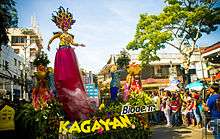
The Higalaay Festival (formerly the Kagay-an Festival, then the Higalaay Kagay-an Festival) is a week-long celebration in honor of Cagayan de Oro's patron saint St. Augustine, held every August.
Highlights of the Higalaay Festival are the Kahimunan Trade Fair, which features the native products of the city and province, particularly agricultural, Miss Cagayan de Oro, Folkloric Street Dancing Competition featuring colorful attires and cultural dances of the Higaonon tribes, Higalas Parade of Cagayan de Oro Icons and Floats, Halad sa Lambagohan, PE Rhythmic Dance Competition, Kalo Festival and Kumbira, a culinary show and exhibit that started in 1996 by Kagay-anons hoteliers and restaurants. It has since evolved over the years and now hosts a culinary competition among students and professionals from all over Mindanao.[24] The competition is divided into students and professionals where Hotel and Restaurant Management schools and professional chefs compete against each other in their respective categories. There are also cultural shows, competitions and celebrity concerts. In more recent years, some of these competitions have been replaced with new ones, such as the Folkloric Street Dancing Competition, which was replaced by the Cagayan de Oro Carnival Parade in 2014.[25]
Himugso, which means birth, is a week-long celebration of Cagayan de Oro's Charter Day and Philippine Independence Day. Charter Day is Cagayan de Oro's cityhood established on June 15, 1950. Independence Day is the national commemoration of the Philippine Declaration of Independence from Spain on June 12, 1898. Both Charter Day and Independence day are non-working holidays and a roster of special activities is lined up annually to mark the dual special occasion.
Cuisine
Cagayan de Oro food cultures include a variety of world cuisines influenced by the city's immigrant history. Western and Austronesian immigrants have made the city famous for pastel bread, chicharrón and Hamon de Cagayan. Some mobile food vendors licensed by the city sell street food like kwek-kwek, fish balls, tempura and proven and grilled meat.
Cagayan de Oro boasts of numerous local, national, and foreign owned restaurants (Chinese and Korean cuisines), eateries, fast-foods, snack bars, bakeshops, and coffee shops that sprout all over the city.
Sports
Cagayan de Oro is the home of the Cagayan de Oro Stars and Cagayan de Oro Rapids basketball teams. This major teams of the city is member community of Mindanao Visayas Basketball Association, an amateur commercial basketball league in southern Philippines sanctioned by the country's National Sports Association for basketball, the Samahang Basketbol ng Pilipinas (SBP). It is also the home of "Holcim MoneyGram-Misamis Oriental" and "Holcim Pryce Pharma", which commencing the Misamis Oriental province. Aside from basketball, Cagayan de Oro is also known for its oldest lawn tennis clubs like the "Golden Friendship Tennis Club". In addition, the city is ornamented with amateur volleyball teams like the Xavier University Volleyball Team.
The city was known for its leading sport, chess, one of the most common recreations by continuing championships in Mindanao since 1990’s. Also, the white water rafting and kayaking has its annual sport events through the Cagayan River.
Also, designate a number of Sport venues, including one of the biggest sports complex in Mindanao the Pelaez Memorial Sports Center, Xavier University-Ateneo de Cagayan Gymnasium, Liceo Civic Center and others, a sports and entertainment complex that also hosts concerts. The Pelaez Memorial Sports Center serves as the home complex of Misamis Oriental sports teams.
Tourism
Due to the national government's aggressive tourism campaign, local and foreign tourist arrivals in the city are on the rise. In 2004, the city registered a tourist arrival of 307,820; an increase from a previous of 232,257 in 2003. Numerous hotels of varying categories are present in the city.
Parks and resorts
- Duaw Park is a riverside park along the Cagayan River, underneath the Ysalina Bridge and next to St. Augustine Cathedral. It was created in August 1987 by former City Mayor Ambing Magtajas, together with 120 Kagay-anons who returned (Du-aw meaning visit) to the city from the USA and Canada after years of self-exile during the Marcos regime.[26][27]
- Gaston Park is located across from St. Augustine Metropolitan Cathedral. This park eventually became an execution ground for Spanish criminals turned later into a training ground for the local revolutionaries during the American occupation. On December 17, 2012, a Memorial Wall was unveiled in remembrance of the people who lost their lives, as well as those who remained missing after Tropical Storm Washi.[28] It has been redeveloped in recent years, with the worn grass being replaced by red tiles.[29] In December 2015, the long-awaited Musical Fountain started running after some delays.[30]
- Plaza Divisoria (Golden Friendship Park) is located in the downtown area. It was built around 1900's as a town divider after a great fire that almost burned down the entire city. The park is dedicated to local and national heroes like former President Ramon Magsaysay, Andrés Bonifacio, Dr. José Rizal, and former Mayor Justiniano R. Borja. Most of the Kagay-anons soldiers who died during the Philippine-American War are buried beneath the monument and has survived the ravages of time including World War II.[7]
- Vicente de Lara Park (McArthur Park) Formerly called MacArthur Park named after American soldier Douglas MacArthur, now Vicente de Lara Park honoring the former governor of the province, is situated in front of the Provincial Capitol of Misamis Oriental building with age-old mahogany trees that provide a therapeutic canopy for the promenades. Because of this, the park is a popular jogging area in the mornings. A Press Freedom Monument and the Heritage Monument of Misamis Oriental designed by renowned Filipino sculptor Eduardo Castrillo can also be found in this redeveloped park.[31][32]
- Gardens of Malasag Eco-Tourism Village is located in a reforested area on Malasag Hill. This 7 hectare village has replicas of tribal houses in the region and a panoramic view of Macajalar Bay. The tourism village is owned and managed by the Philippine Tourism Authority.[33]
- Plaza de Los Heroes is a memorial park dedicated to the heroes of the Three Battles of Cagayan de Oro during the Philippine-American War located along Mastersons Avenue in upper Carmen.
- Mapawa Nature Park is for horseback riding, biking, zip line and nature trekking adventures.
- Monigue Cave is located in barangay Mambuaya this city; the cave entrance is flowing water from underground stream. The cave has a small opening that seems too narrow to be passable, it has a six inches airspace between ceiling and water that you have submerge yourselves one by one, equipped with a helmet and a waterproof cap lamp. It contains a beautiful sparkling formation, which is called the Calcium Carbonates (CaCO3) or Calcites. These stalactites and stalagmites, white and brown, are sign of oxidized materials that take 50 to 60 years to form an inch the cave is definitely spellbinding. There were formations of flowstone, gurpool-resembling, rice terraces, transparent crystals and picturesque speleothems, such as cathedral drapes and icons.
- Catanico Falls is concealed by huge boulders, rapids, cascading falls and natural pool of Barangay F.S. Catanico.
- Palalan Falls is surrounded by boulders and stones dubbed by the city as "Oro" stone similar in characteristics with the Mangima stone.
- Migtugsok Falls is located at barangay Cugman and it is composed of five beautiful cascading waters, where the beauty of nature could be experienced, unexploited by the carelessness of human search for progress and development.
- Kagay-an Resort (Lawndale Spring Resort) is located in Barangay Taguanao, and is usually packed with families and groups on weekends lounging in the cold springs.
Museums and historical places
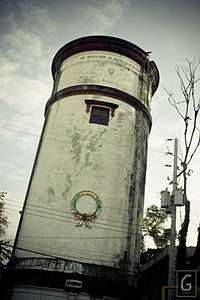
- City Archives Museum is a museum located inside the Old Water Tower built around 1922, near St. Augustine Cathedral and across from Gaston Park. Recently, it was upgraded into a museum that houses antiquities, memorabilia of well-known families in the city and a gallery parade of Cagayan de Oro history.
- Gen. McArthur Memorial Marker is a historical marker located near the Port of Cagayan de Oro; the monument commemorates two historical events.
- Museo de Oro is a museum located within the main campus of Xavier University - Ateneo de Cagayan. The museum exhibits artifacts dug from Huluga Caves and repertoire of Bukidnon, and the Maranao cultures that have survived the ravages of time.[7]
- Museum of Three Cultures is a museum of Capitol University. It houses a gallery of Maranao antiquities from Tugaya, Lanao del Sur; a gallery of ethno history which shall display Cagayan de Oro history, Butuan archaeological artifacts, lumad arts and crafts from the Higaonon and Manobo cultures, and a treasure of Christians lowland artifacts of Northern Mindanao region; and finally an art gallery and coffee shop that promotes the local visual arts of Mindanao. It also has a research archives that will house Spanish era written documents, photographs, memorabilia of well-known personalities in Mindanao, which is open to all researchers and students of culture.
- La Castilla is a museum of the Philippine household heirlooms and antiques. This is the Peláez family memorabilia administered by the Liceo de Cagayan University.
- DXCC Museum is a museum of a well-known radio broadcasting station in the Philippines called RMN-DXCC located at Don Apolinar Velez street.
- Executive Building (Old City Hall) used to be known as Casa Real de Cagayán, it was a former Spanish Governors' residence and seat of present-day local government officials.
- MOGCHS Administration Building was part of the 1907 Gabaldon initiatives to established and build public schools all over the Philippines under the Americans regime.
- Casa del Chino Ygua (Balay na Bato) was built in 1882 by the Sia family; they were the first Chinese migrants in Cagayan de Oro. Most of the revolutionaries died and buried behind the house during the Philippine-American War.
- Makahambus Cave and Adventure Park is an underground cave with a 130 feet (40 m) circular gorge. The ravine is thick with various species of plants and huge trees. It is the site of the historic Battle of Makahambus Hill between Kagay-anons and American soldiers during the Philippine-American War circa 1900's .[34]
- Huluga Caves. is an archaeological site in Sitio Taguanao, barangay Indahag. Huluga Caves is composed of an open site and two caves where skeletal remains of a child and woman were found. A fragment of the woman's skull was 377 A.D. by the Scripps Institution of Oceanography in La Jolla, California, United States. The open site is the venue of a prehistoric settlement.
Hotels
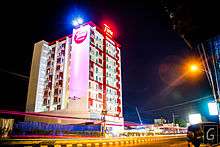
Recent data from the Department of Tourism show that Cagayan de Oro is among the top 20 most visited tourist destinations in the country. As a result, international hotel chains are attracted to put up their hotel accommodations in or near the city.
Infrastructure
Transportation
As the gateway to Northern Mindanao and the rest of Mindanao, Cagayan de Oro is very accessible via land, air and water transportation.
Ports
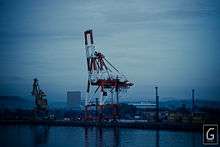
The Port of Cagayan de Oro in Macabalan is located near the estuary of the Cagayan de Oro River. It has an anchorage depth of 18 meters and is around 400 meters from the shoreline. It has two authorized cargo-handling operators. With the recent completion of the P250 million rehabilitation project, the port is now the biggest international and domestic seaport in Mindanao.[36] It handled 1.399 million metric tons of cargoes during the first quarter of 2016 to rank 3rd in the country after Manila's North Harbor with 5.557 million metric tons and MICT with 3.746 million metric tons. The Port of Cagayan de Oro increased its volume of cargoes by 9.7% from 2015. This is according to data from the Philippine Ports Authority (PPA).
The Port of Cagayan de Oro (Macabalan Port) serves regular trips to and from cities of Metro Manila, Cebu City, Tagbilaran, Bacolod, Dumaguete, Iloilo City and Jagna, Bohol.
General Milling and Del Monte Philippines also operate their own port facilities within Cagayan de Oro. The $85 million Mindanao International Container Port located in nearby town Tagoloan 17 kilometers from Cagayan de Oro serves the PHIVIDEC Industrial Estate. This city's sub-port connects Mindanao to the ports of major cities in Visayas, Batangas, Metro Manila and the rest of the world.
Airport
Laguindingan Airport handles domestic flights to and from Manila, Cebu City, Iloilo City and Davao City. It sits on a 4.17 square kilometres (1.61 sq mi) site in Barangay Moog, Laguindingan, some 46 kilometres (29 mi) northwest of Cagayan de Oro.[37] The airport was inaugurated on January 11, 2006 by former President Gloria Macapagal-Arroyo, who advocated the idea of an international airport along the Cagayan de Oro-Iligan Corridor,[38] and was officially opened on June 15, 2013. Laguindingan Airport, one of the national government's flagship projects to boost the nation's tourism industry, is destined to become an international airport serving Northern Mindanao and Lanao del Sur.
Bus terminals
Several means of public transportation are also available within the city. A number of companies also operate taxi services. There are also a couple of river taxis that ply down to the Cagayan de Oro River for both locals and tourists.
The Eastbound integrated Bus Terminal (Agora) offers a regular landtrips to and from eastern municipalities of Misamis Oriental including Balingoan and Gingoog, Carmen (proposed), Nasipit, Butuan, Bukidnon including Malaybalay and Valencia, Davao City, Kabacan, Tacurong and General Santos City.
The Westbound Integrated Bus and Jeepney Terminal also has regular land trips to and from western municipalities of Misamis Oriental including El Salvador and Laguindingan, Iligan, Marawi, Tangub, Ozamiz, Dapitan, Dipolog, and the rest of Zamboanga Peninsula including Pagadian and Zamboanga City.
Public utilities
Land-based and mobile phone services: There are five major land-based phone companies: MisOrTel, PLDT-PhilCom, Smart Broadband (formerly Cruztelco), BayanTel and ItalTel that serve the city. Mobile phone services are provided by Globe Telecom, Smart Communications and Sun Cellular. Internet and BPO providers: There are several internet providers operating in the city offering dial up, broadband, Wi-Fi and cable services. Pueblo de Oro Business IT Park located in Upper Carmen is the first PEZA-registered IT park in Mindanao. The IT Park currently houses one of Cagayan de Oro's call centers. Water services: Water services are provided by the Cagayan de Oro Water District (COWD), it was the first water district established in the entire Philippines. Electricity services: Electricity in the City is provided mainly by Cagayan Electric Power and Light Company (CEPALCO) and partly by Misamis Oriental -1 Rural Electric Service Cooperative (MORESCO-1). Cagayan Electric Power and Light Company (CEPALCO). CEPALCO, which began operations in 1952, covers almost all of Cagayan de Oro and the Municipalities of Tagoloan, Villanueva and Jasaan, all in the Province of Misamis Oriental, including the 3,000-hectare PHIVIDEC Industrial Estate and caters to more than 100,000 consumers. The company's distribution system network now includes 138KV, 69KV, 34.5KV and 13.8KV systems. CEPALCO is also operating the developing world's first and largest (at the time of its inauguration in 2004) on-grid Solar Photovoltaic power plant. The 1-megawatt polycrystalline silicon-based Photovoltaic (PV) plant in Barangay Indahag of this city is connected with the distribution network of CEPALCO. It is the biggest solar power plant connected to the power grid in Southeast Asia.[39] Misamis Oriental -1 Rural Electric Service Cooperative (MORESCO-1) whose office is located in Laguindingan covers remote parts of Cagayan de Oro. These are barangays Canitoan, Pagatpat, San Simon, and Baikingon.
Law and order
Cagayan de Oro is the regional base of Philippine Air Force, Philippine Army, and Philippine National Police in Northern Mindanao.
The Philippine Air Force is using Lumbia Airport as its air base which is currently operating a service equipment of OV-10 Bronco aircraft as well as UH-1 Huey and MD-520MG Defender helicopters. This will be a future home of the 15th Air Strike Wing that will be moving out from Sangley Point in Cavite
The Philippine Army operates the largest military camp in Mindanao located in Barangay Patag with an area of 129 hectares. It is home to the 4th infantry division of the Philippine Army. Camp Evangelista's external jurisdiction covers the Northern Mindanao and Caraga regions. Minor military camps are also located in barangay Lumbia and upper Puerto.
The Philippine National Police also operates its Regional Headquarters at Camp Alagar in Barangay Lapasan. Camp Alagar has jurisdiction over the entire Northern Mindanao, namely the Provinces of Bukidnon, Camiguin, Lanao del Norte, Misamis Occidental and Misamis Oriental including its major cities; Cagayan de Oro and Iligan.[40]
Medical facilities
Cagayan de Oro has a hospital bed-to-population ratio of 1:474 as of 2003. The Justiniano R. Borja Memorial Medical Hospital (formerly City Hospital), Puerto Community Hospital and Northern Mindanao Medical Center (formerly Provincial Hospital) are the three government-run hospitals.
Capitol University Medical City, Polymedic General Hospital, Polymedic Medical Plaza, Maria Reyna–Xavier University Hospital, Cagayan de Oro Medical Center, Madonna and Child Hospital, Sabal Hospital and Maternity-Children's Hospital and Puericulture Center (formerly Oro Doctor's Hospital) are privately owned.
Many of these government-owned and privately-owned hospital facilities have undergone expansion, renovation and modernization.
Education
The city has four major private universities/colleges: Capitol University, Liceo de Cagayan University, Lourdes College Cagayan de Oro City, and Xavier University – Ateneo de Cagayan. The Mindanao University of Science and Technology is the only state university in the city. Other higher education institutions include Southern Philippines College, Pilgrim Christian College, Cagayan de Oro College, St. Mary's Academy of Carmen run by the RVM Sisters, Informatics Computer Institute and STI College - Cagayan de Oro with a secondary education program in Barangay Kauswagan. There are also a number of foreign schools in the city with study programs.
Notable public and private elementary and high schools include Cagayan de Oro National High School, Misamis Oriental General Comprehensive High School, Gusa Regional Science High School - X, City Central School, St. Mary's School, Corpus Christi School, The Abba's Orchard Montessori School, Merry Child School, International School, Vineyard International Polytechnic College, and Montessori de Oro. There are also schools in Cagayan de Oro that use the Accelerated Christian Education system. Two of these schools include Cavite Bible Baptist Academy-CDO branch, and Shekinah Glory Christian Academy. There are two Chinese schools in the city: Kong Hua School (Roman Catholic) and Oro Christian Grace School (an Evangelical Christian school). There are two international schools run by Koreans, namely: Nanuri International School and Immanuel Mission International School.[41]
Media
Notable media publications in the city are the Mindanao Gold Star Daily, SunStar Cagayan de Oro, and Super Balita. Ang Katarungan is the city's major English-Cebuano language paper published since 1926. Brigada Newspaper Cagayan de Oro is the most popular newspaper company in the city.
There are ten television stations in the city that are owned and operated by broadcasting networks—ETC Channel 4, CNN Philippines Channel 5, ABS-CBN TV-2/23, GMA TV-12/35, 2nd Avenue TV-31, RMN/BEAM 8/33, TV5 Channel 21, Channel 45 Global News Network, GMA News TV Channel 43, S+A Channel 7 and the eleventh television station, is operated by the Cagayan de Oro College Broadcast Network. Parasat Cable TV and Jade Cable TV are the two cable systems in the city.
There are two local newscasts programs in Cagayan de Oro: TV Patrol Northern Mindanao (ABS-CBN Cagayan de Oro), and 24 Oras Northern Mindanao (GMA Northern Mindanao after it was launched in 2013 also known as Testigo Northern Mindanao and later re-launched as 24 Oras Northern Mindanao effective November 10, 2014).
Local government
Elected and appointed public officials have governed Cagayan de Oro since June 15, 1950, with a strong mayor-council government. The city political government is composed of the mayor, vice-mayor, two congressional districts representatives, sixteen councilors, one Sangguniang Kabataan (SK) Federation representative and an Association of Barangay Captains (ABC) representative. Each official is elected publicly to a three-year terms.
The following are the current city officials of Cagayan de Oro:[42]
- House of Representatives
- 1st leg. district: Rep. Rolando A. Uy (PDP-Laban)
- 2nd leg. district: Rep. Maximo Rodriguez (PDP-Laban / CDP)
- City mayor: Hon. Oscar S. Moreno (LP)
- Vice-mayor: Hon. Raineir Joaquin Uy (LP)
Barangay and legislative districts
Cagayan de Oro is politically subdivided into 80 barangays. These are grouped into two congressional districts, 24 barangays in the 1st district (West) and 56 barangays in the 2nd district (East), with the Cagayan de Oro River as the natural boundary. The city has a 57 urbanized barangays and 23 rural barangays all in all.
| District | Sub-District (# of Barangays) | Population (as of 2010) | Barangays | ||||
|---|---|---|---|---|---|---|---|
| First | Non-Poblacion (24) | 290,913 |
| ||||
| Second | Non-Poblacion (16) | 98,586 |
| ||||
| Poblacion (40) |
| ||||||
Notable people

- Pia Wurtzbach – Miss Universe Philippines 2015, Miss Universe 2015; resided in Cagayan de Oro
- Maria Isabel Lopez – Binibining Pilipinas Universe 1982
- Elizabeth Berroya – Binibining Pilipinas Universe 1992
- Mark Bautista – singer, songwriter, theater actor
- Aquilino "Nene" Pimentel, Jr. - former Senate President
- Aquilino "Koko" Pimentel III - Senate President under President Rodrigo Roa Duterte
- Milan Melindo - professional boxer
- Ciso Morales - professional boxer
- Jason Pagara - professional boxer
- Albert Pagara - professional boxer
- Maricar Reyes - Filipino actress
- Martin Andanar - Secretary of the Presidential Communications Operations Office under President Rodrigo Roa Duterte
International relations
Twin towns or sister cities
Cagayan de Oro has sister cities worldwide including local, as classified by the city government.
 Lawndale, United States (1986)[43][44]
Lawndale, United States (1986)[43][44] Tainan City, Taiwan (2005)[45]
Tainan City, Taiwan (2005)[45] Harbin, China (2007)[46]
Harbin, China (2007)[46] Norfolk, United States (2008)[47]
Norfolk, United States (2008)[47] Gwangyang, South Korea (n/a)[48]
Gwangyang, South Korea (n/a)[48] Quezon City, Philippines (n/a)[49]
Quezon City, Philippines (n/a)[49]
See also
Gallery
-
.jpg)
Skyline of Cagayan de Oro as of Oct. 26, 2015
-
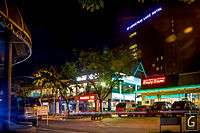
North Concourse, Limketkai Center
-

CM Recto Flyover
-
Whitewater rafting or kayaking adventures in the Cagayan de Oro River
-

A Tribute monument to the slain members of the press
References
- ↑ "Official City/Municipal 2013 Election Results". Intramuros, Manila, Philippines: Commission on Elections (COMELEC). 12 May 2014. Retrieved 26 June 2014.
- ↑ "Province: MISAMIS ORIENTAL". PSGC Interactive. Makati City, Philippines: National Statistical Coordination Board. Archived from the original on 1 January 1970. Retrieved 26 June 2014.
- 1 2 3 4 "Region X (NORTHERN MINDANAO)". Census of Population (2015): Total Population by Province, City, Municipality and Barangay (Report). PSA. Retrieved 20 June 2016.
- ↑ Cities of the Philippines
- ↑ http://dirp3.pids.gov.ph/ris/dps/pidsdps9831.pdf
- ↑ "Cagayan de Oro's White Water Rafting". Philippine Postal Corporation. June 18, 2012. Retrieved September 13, 2012.
- 1 2 3 Cagayan De Oro Travel Guide
- ↑ GMA goes whitewater rafting in Cagayan de Oro - and looks forward to mountain climbing : Philippines : Gov.Ph : News
- ↑ http://cagayandeoro.elizaga.net/Appendix/meaning-of-cagayan.html
- ↑ Montalvan, Antonio J. II (October 16, 2009). "History of Cagayan de Oro". Heritage Conservation Advocates. p. 2. Retrieved September 13, 2012.
- ↑ "Unsung Heroes of the Philippine Revolution: Ang mga Pilipino sa Ating Kasaysayan, a Centennial Resource Book". MSC Institute of Technology. Retrieved September 13, 2012.
- ↑ Berlow, Alan (July 4, 1996). "The Independence Day That Wasn't". Philippine Centennial Series. Philippine History Group of Los Angeles. Retrieved September 13, 2012.
- ↑ The 1st Congress of the Philippines (June 15, 1948). "R.A. No. 268, An Act Creating the Municipality of El Salvador, Province of Misamis Oriental". Philippine Law Info. Retrieved April 8, 2011.
- ↑ The 2nd Congress of the Philippines (June 15, 1950). "R.A. No. 524, An Act Creating the Municipality of Opol, Province of Misamis Oriental". Philippine Law Info. Retrieved April 9, 2011.
- ↑ The 2nd Congress of the Philippines (June 15, 1950). "R.A. No. 521, Cagayan de Oro City Charter". Philippine Law Info. Retrieved September 13, 2012.
- ↑ Roa, A. Paulita (June 15, 2012). "The City of Cagayan de Oro". Feature. Sun.Star Cagayan de Oro. Retrieved September 13, 2012.
- ↑ Ressa, Maria (December 19, 2011). "Storm death toll tops 650 in Philippines; hundreds missing". Asia. CNN. Retrieved September 13, 2012.
- ↑ "Death toll from Typhoon Bopha tops 1,000 in the Philippines - CNN.com". CNN. Retrieved 2015-08-06.
- ↑ "The Official Website of Cagayan de Oro City". The City Government of Cagayan de Oro City. Retrieved September 13, 2012.
- ↑ "Cagayan de Oro, Philippines: Monthly - Weather Averages Summary". Weatherbase. CantyMedia. 2016. Retrieved February 4, 2007.
- ↑ "Total Population by Province, City, Municipality and Barangay: as of May 1, 2010" (PDF). 2010 Census of Population and Housing. National Statistics Office. Archived from the original (PDF) on 20 March 2013. Retrieved 26 June 2014.
- ↑ "Cagayan de Oro City: Population growth rate declined to 1.63 percent". National Statistics Office. September 17, 2002. Archived from the original on February 21, 2012. Retrieved September 13, 2012.
- ↑ "Cagayan de Oro". Philippine Airlines. Retrieved September 13, 2012.
- ↑ "Kagay-an Festival". CDO Guide: Your Online Guide to Cagayan de Oro. Retrieved September 13, 2012.
- ↑ "Cagayan de Oro Carnival Parade". ACadeO:What To Do in Cagayan de Oro. Retrieved November 3, 2015.
- ↑ "Overseas Kagay-anon Hail Moreno victory | Kagay-an®". www.kagay-an.com. Retrieved 2015-08-06.
- ↑ "Where is Du-aw Park?". TsadaGyud!. Retrieved 2015-08-06.
- ↑ "Remembering Sending - the Memorial Wall". Wow CDO. Retrieved November 28, 2016.
- ↑ "PROJECT WATCH: Gaston Park redevelopment nears completion". www.CDODev.Com | PROGRESS WATCH : Cagayan de Oro and Misamis Oriental. Retrieved 2015-08-06.
- ↑ "PROJECT WATCH: Gaston Park Musical Fountain now up and running". www.CDODev.Com | PROGRESS WATCH : Cagayan de Oro and Misamis Oriental. Retrieved 2016-01-17.
- ↑ "PROJECT WATCH: Heritage Monument unveiled". www.CDODev.Com | PROGRESS WATCH : Cagayan de Oro and Misamis Oriental. Retrieved 2015-08-08.
- ↑ "PROJECT WATCH: Press Freedom Monument finally unveiled". www.CDODev.Com | PROGRESS WATCH : Cagayan de Oro and Misamis Oriental. Retrieved 2015-08-08.
- ↑ Gardens of Malasag Eco-Tourism Village
- ↑ "Archived copy". Archived from the original on 2007-10-11. Retrieved 2007-11-30.
- ↑ "Port of Cagayan de Oro". Philippine Ports Authority. Retrieved September 13, 2012.
- ↑ P250-M rehab for Mindanao’s biggest port completed - INQUIRER.net, Philippine News for Filipinos Archived October 15, 2007, at the Wayback Machine.
- ↑ Rodriguez, Ma. Cecilia (July 22, 2007). "Waiting for the flight from Laguindingan". Inquirer Headlines - Regions. Inquirer Mobile. Retrieved September 13, 2012.
- ↑ Cabahug-Aguhob, Rutchie (December 14, 2009). "Pres. Arroyo inaugurates 17,000th km-milestone FMR" (Press release). Philippine Information Agency. Retrieved September 13, 2012.
- ↑ "CEPALCO'S 1MWP Photovoltaic Power Plant". Cagayan Electric Power and Light Company. Retrieved September 13, 2012.
- ↑
- WWW.PNP.GOV.PH :: Philippine National Police
- ↑ The 14th Congress of the Philippines (January 7, 2009). "R.A. No. 9519, Mindanao University of Science and Technology Charter". Philippine Law Info. Retrieved September 13, 2012.
- ↑ "Officials in Cagayan de Oro City". Elizaga. Retrieved September 13, 2012.
- ↑ "South Bay Facts". Los Angeles Times. July 31, 1986. Retrieved September 13, 2012.
- ↑ "Minutes of the Lawndele City Council Regular Meeting" (PDF). City Government of Lawndale City. December 19, 2011. p. 8. Retrieved September 13, 2012.
- ↑ Fuentes Ian A. CdeO To Get 5 Fire Trucks Donation From Tainan , www.cagayandeoro.gov.ph Archived August 3, 2013, at the Wayback Machine.
- ↑ Jaraula Attends Int\\\'l Trade Fair In Harbin , www.cagayandeoro.gov.ph Archived August 3, 2013, at the Wayback Machine.
- ↑ Elson T. Elizaga Neglecting Our Ancient City , Letter.
- ↑ Cagayan De Oro City adopts Gwangyang, Korea as sister city, Philippine Information Agency
- ↑ "Sister Cities". Local Government of Quezon City. Retrieved 22 August 2016.
External links
| Wikimedia Commons has media related to Cagayan de Oro. |
 Cagayan de Oro travel guide from Wikivoyage
Cagayan de Oro travel guide from Wikivoyage- Official website of the city government of Cagayan de Oro
- Cagayan de Oro development updates
- LGU Performance Management System
- Cagayan de Oro Encyclopedia
 |
Macajalar Bay | Tagoloan |  | |
| Opol | |
Manolo Fortich, Bukidnon | ||
| ||||
| | ||||
| Iligan City | Talakag / Baungon / Libona, Bukidnon |
